Behrouz Farhang-Boroujeny
The University of Utah
Filtered Multi-Tone Spread Spectrum with Overlapping Subbands
Mar 26, 2025Abstract:A new form of the filter bank multi-carrier spread spectrum (FBMC-SS) waveform is presented. This new waveform modifies the filtered multi-tone spread spectrum (FMT-SS) system, and is intended to whiten the power spectral density (PSD) of the transmit signal. In the conventional FMT-SS, subcarrier bands are non-overlapping, leaving a spectral null between the adjacent subcarrier bands. To make FMT-SS more appealing for a broader set of applications than those studied in the past, we propose adding additional subcarriers centered at these nulls and thoroughly explore the impact of the added subcarriers on the system performance. This modified form of FMT-SS is referred to as overlapped FMT-SS (OFMT-SS). We explore the conditions required for maximally flattening the PSD of the synthesized OFMT-SS signal and for cancelling the interference caused by overlapping subbands. We also explore the choices of spreading gains that result in a low peak-to-average power ratio (PAPR) for a number of different scenarios. Further reduction of the PAPR of the synthesized signal through clipping methods is also explored. Additionally, we propose methods of multi-coding for increasing the data rate of the OFMT-SS waveform, while minimally impacting its PAPR.
Theoretical Analysis of Multi-coding with Non-orthogonal Signaling
Mar 10, 2025Abstract:Even though orthogonal multi-code signaling and its derivative, simplex signaling, are well known and widely used in different communication systems, certain applications may choose to adopt non-orthogonal signaling to benefit from other advantages that such signaling methods can offer. Motivated by a class of multi-carrier spread spectrum systems, this paper presents a thorough symbol error rate analysis of the broad class of multi-code signaling methods when they make use of codes which are not necessarily orthogonal. Our analysis is also extended to the case where the code set includes the negative of each code vector, i.e., an extension to biorthogonal signaling. Moreover, it is shown that the symbol error rate results derived in this paper reduce to those available in the literature when the multi-codes are orthogonal or satisfy the correlation property of simplex multi-codes.
UWB Narrowband Interference Survey and Design Considerations
Nov 11, 2024Abstract:A study of interference caused by incumbent radios to UWB devices is presented. Through an extensive set of measured spectral activities in the low-band IEEE802.15.4 UWB operating channels, we explore the outage probabilities of a UWB system when it is equipped with an intelligent detector for combating interferers and compare them against those of a naive system that has no interference avoidance capability. Our results reveal that a UWB system with an effective interference avoidance capability may lead to a few orders of magnitude improvement in its outage probabilities. The measured outage probabilities are confirmed through measuring the frame error rate of a simulated filter-bank UWB transceiver system when impacted by the interferences obtained through our experiments.
Filter-Banks for Ultra-Wideband Communications: Advantages and Design Challenges
Nov 08, 2024Abstract:Recently, filter-bank multicarrier spread spectrum (FBMC-SS) has been proposed as a candidate waveform for ultra-wideband (UWB) communications. It has been noted that FBMC-SS is a perfect match to this application, leading to a trivial method of matching to the required spectral mask at different regions of the world. FBMC-SS also allows easy rejection of high-power interfering signals that may appear over different parts of the UWB spectral band. In this paper, we concentrate on the use of staggered multitone spread spectrum (SMT-SS) for UWB communications. SMT makes use of offset quadrature amplitude modulation (OQAM) to transmit data symbols over narrowband, overlapping subcarrier bands. This form of FBMC-SS is well-suited to UWB communications because it has good spectral efficiency and a flat power spectral density (PSD), resulting in good utilization of the UWB spectral mask. Additionally, we explore new methods for multi-coding that result in higher bit rates than previous FBMC-SS systems. Moreover, we study methods for equalizing the UWB multipath channel and cancelling narrowband interference. Excellent performance of the proposed methods are substantiated by presenting simulation results.
Multicarrier Spread Spectrum Communications with Noncontiguous Subcarrier Bands for HF Skywave Links
Sep 15, 2024Abstract:Growing traffic over the high-frequency (HF) band poses significant challenges to establishing robust communication links. While existing spread-spectrum HF transceivers are, to some degree, robust against harsh HF channel conditions, their performance significantly degrades in the presence of strong co-channel interference. To improve performance in congested channel conditions, we propose a filter-bank based multicarrier spread-spectrum waveform with noncontiguous subcarrier bands. The use of noncontiguous subcarriers allows the system to at once leverage the robustness of a wideband system while retaining the frequency agility of a narrowband system. In this study, we explore differences between contiguous and noncontiguous systems by considering their respective peak-to-average power ratios (PAPRs) and matched-filter responses. Additionally, we develop a modified filter-bank receiver structure to facilitate both efficient signal processing and noncontiguous channel estimation. We conclude by presenting simulated and over-the-air results of the noncontiguous waveform, demonstrating both its robustness in harsh HF channels and its enhanced performance in congested spectral conditions.
Downlink Transmission in FBMC-based Massive MIMO with Co-located and Distributed Antennas
Nov 17, 2023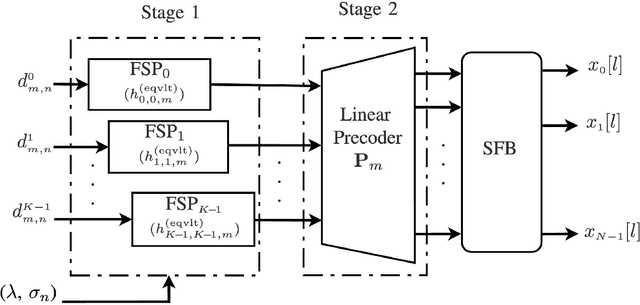
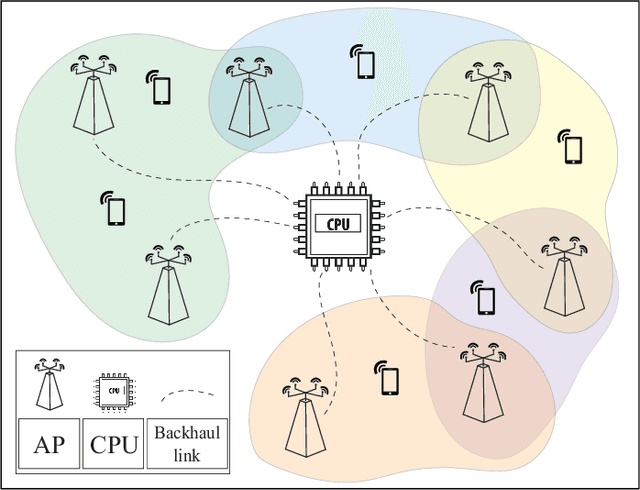
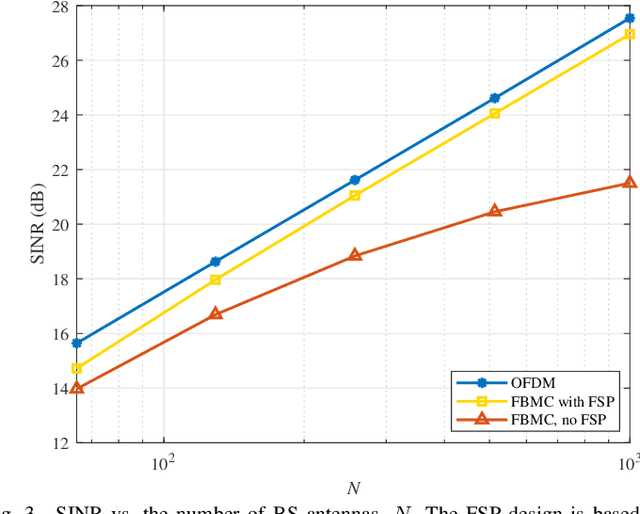
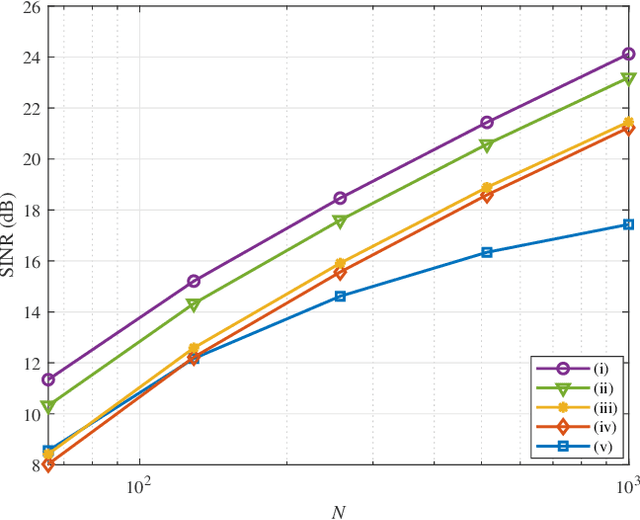
Abstract:This paper introduces a practical precoding method for the downlink of Filter Bank Multicarrier-based (FBMC-based) massive multiple-input multiple-output (MIMO) systems. The proposed method comprises a two-stage precoder, consisting of a fractionally spaced prefilter (FSP) per subcarrier to equalize the channel across each subcarrier band. This is followed by a conventional precoder that concentrates the signals of different users at their spatial locations, ensuring each user receives only the intended information. In practical scenarios, a perfect channel reciprocity may not hold due to radio chain mismatches in the uplink and downlink. Moreover, the channel state information (CSI) may not be perfectly known at the base station. To address these issues, we theoretically analyze the performance of the proposed precoder in presence of imperfect CSI and channel reciprocity calibration errors. Our investigation covers both co-located (cell-based) and cell-free massive MIMO cases. In the cell-free massive MIMO setup, we propose an access point selection method based on the received SINRs of different users in the uplink. Finally, we conduct numerical evaluations to assess the performance of the proposed precoder. Our results demonstrate the excellent performance of the proposed precoder when compared with the orthogonal frequency division multiplexing (OFDM) method as a benchmark.
Resource Allocation for Single Carrier Massive MIMO Systems
Feb 28, 2022
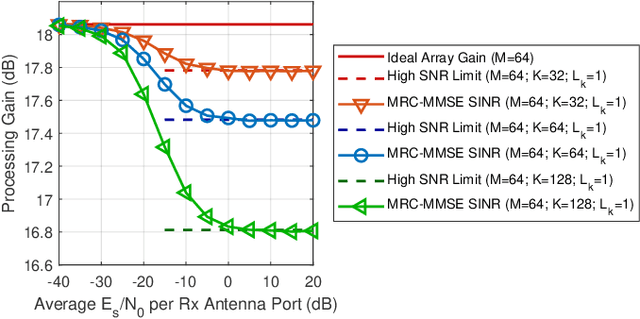

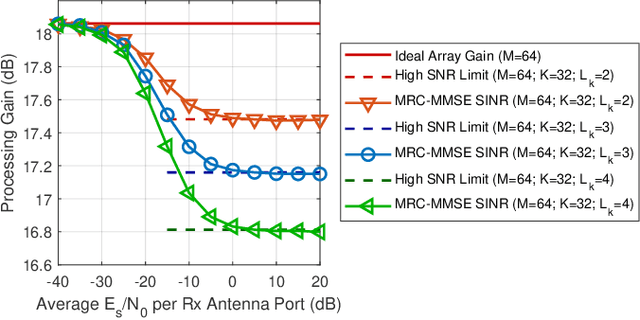
Abstract:Resource allocation in orthogonal frequency division multiplexing (OFDM) systems is performed through allocating blocks of subcarriers to each user. Even though OFDM is the primary waveform for 5G NR systems, research reports have noted that single carrier modulation (SCM) offers several advantages over OFDM in massive multiple input multiple output (MIMO) systems, making it a preferred candidate for some future applications such as massive machine type communications (mMTC). This paper presents a method for SCM resource allocation and the relevant information recovery algorithms at the receiver. Our emphasis is on cyclic prefixed SCM, where highly flexible and efficient frequency domain detection algorithms enable the operation of many simultaneous users in a massive MIMO uplink scenario. The proposed resource allocation method allows the number of users to exceed the number of antennas at the base station (BS). Each single carrier transmission is partitioned into $L$ interleaved streams, and each user is allocated a number of such streams. One major benefit of SCM is that each data symbol is spread over the entire bandwidth. As such, the receiver performance is dictated by the average channel gain across the transmission band rather than the channel gain at a given frequency bin or a small group of frequencies. In the proposed setup, each stream may be thought of as a resource block in SCM, analogous to resource blocks in OFDM. Hence, in the context of this paper, the terms resource blocks and streams may be used interchangeably.
Downlink Precoding for FBMC-based Massive MIMO with Imperfect Channel Reciprocity
Jan 26, 2022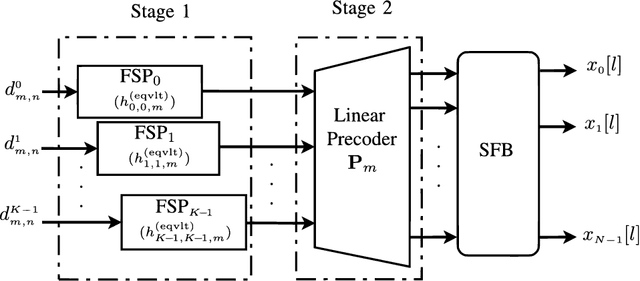
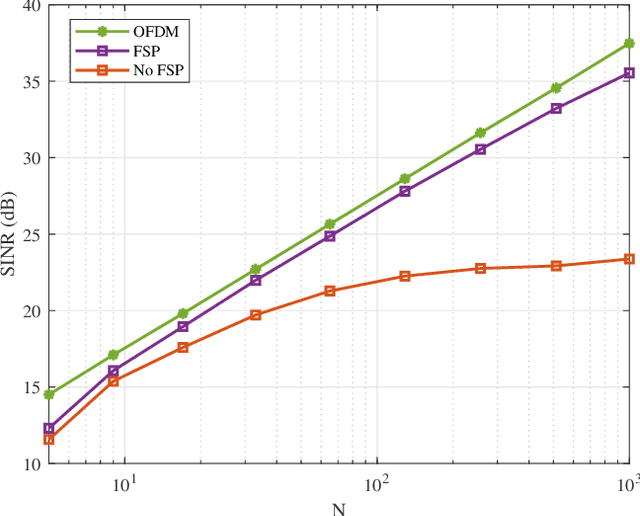
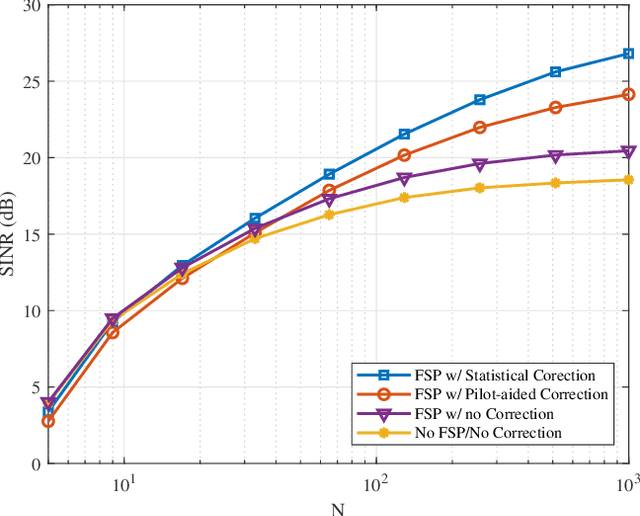
Abstract:In this paper, a practical precoding method for the downlink of filter bank multicarrier-based (FBMC-based) massive multiple-input multiple-output (MIMO) is developed. The proposed method includes a two-stage precoder consisting of a fractionally spaced prefilter (FSP) per subcarrier for flattening/equalizing the channel across the subcarrier band, followed by a conventional precoder whose goal is to concentrate the signals of different users at their spatial locations. This way, each user receives only the intended information. In this paper, we take note that channel reciprocity may not hold perfectly in practical scenarios due to the mismatch of radio chains in uplink and downlink. Additionally, channel state information (CSI) at the base station may not be perfectly known. This, together with imperfect channel reciprocity can lead to detrimental effects on the downlink precoder performance. We theoretically analyze the performance of the proposed precoder in the presence of imperfect CSI and channel reciprocity calibration errors. This leads to an effective method for compensating these effects. Finally, we numerically evaluate the performance of the proposed precoder. Our results show that the proposed precoder leads to an excellent performance when benchmarked against OFDM.
FBMC Receiver Design and Analysis for Medium and Large Scale Antenna Systems
Mar 23, 2021



Abstract:In this paper, we design receivers for filter bank multicarrier-based (FBMC-based) massive MIMO considering practical aspects such as channel estimation and equalization. In particular, we propose a spectrally efficient pilot structure and a channel estimation technique in the uplink to jointly estimate all the users' channel impulse responses. We mathematically analyze our proposed channel estimator and find the statistics of the channel estimation errors. These statistics are incorporated into our proposed equalizers to deal with the imperfect channel state information (CSI) effect. We revisit the channel equalization problem for FBMC-based massive MIMO, address the shortcomings of the existing equalizers in the literature, and make them more applicable to practical scenarios. The proposed receiver in this paper consists of two stages. In the first stage, a linear combining of the received signals at the base station (BS) antennas provides a coarse channel equalization and removes any multiuser interference. In the second stage, a per subcarrier fractionally spaced equalizer (FSE) takes care of any residual distortion of the channel for the user of interest. We propose an FSE design based on the equivalent channel at the linear combiner output. This enables the applicability of our proposed technique to small and/or distributed antenna setups such as cell-free massive MIMO. Finally, the efficacy of the proposed techniques is corroborated through numerical analysis.
Efficient Precoding for Single Carrier Modulation in Multi-User Massive MIMO Networks
Mar 13, 2021

Abstract:By processing in the frequency domain (FD), massive MIMO systems can approach the theoretical per-user capacity using a single carrier modulation (SCM) waveform with a cyclic prefix. Minimum mean squared error (MMSE) detection and zero forcing (ZF) precoding have been shown to effectively cancel multi-user interference while compensating for inter-symbol interference. In this paper, we present a modified downlink precoding approach in the FD based on regularized zero forcing (RZF), which reuses the matrix inverses calculated as part of the FD MMSE uplink detection. By reusing these calculations, the computational complexity of the RZF precoder is drastically lowered, compared to the ZF precoder. Introduction of the regularization in RZF leads to a bias in the detected data symbols at the user terminals. We show this bias can be removed by incorporating a scaling factor at the receiver. Furthermore, it is noted that user powers have to be optimized to strike a balance between noise and interference seen at each user terminal. The resulting performance of the RZF precoder exceeds that of the ZF precoder for low and moderate input signal-to-noise ratio (SNR) conditions, and performance is equal for high input SNR. These results are established and confirmed by analysis and simulation.
 Add to Chrome
Add to Chrome Add to Firefox
Add to Firefox Add to Edge
Add to Edge